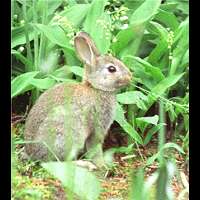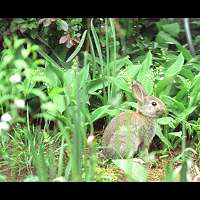The Rabbit (Oryctolagus cuniculus)
Rabbits are very similar to rodents. They apparently eat the same way, breed very fast and have more or less the same built. But they are no rodents. They are placed in their own order called Lagomorpha. This is a very small order with some 60 species only. Divided into three groups: pikas, rabbits and hares. The difference between rodents and Lagomorphs is anatomical mainly and hard to see in the field, except for the fact that Lagomorphs only have a very short tail or no apparent tail at all. In Western Europe only two species exist: the Hare and the Rabbit. In Northern Europe (including Ireland, Scotland and Northern England) and the Alps a third species can be found: the Mountain Hare, which is entirely white in winter. Reaching a length of some 50 centimeters and weighing some 3 kilograms tops the Rabbit is much smaller than the Hare. The Rabbit is quite variable in colour, but usually it is greyish or yellowish brown on top and white below. Albinism is not uncommon among rabbits producing white animals. Locally black specimens also occur. As wild rabbits do cross with escaped cultivars one sometimes sees strangely coloured specimens.
Contents: 1 rabbits in the garden, 2 reproduction, 3 eaten and being eaten, 4 distribution.
1 Rabbits in the garden
Should you live in an area where rabbits occur, you might expect them in your garden one day. Even though sometimes present during daylight, they usually turn up at dusk and dawn. A rabbit rarely appears by itself, usually a group, often a family, will discover your garden and turn up regularly. When you have a very big garden, which is not neatly planned and where no vegetables are grown, you may enjoy the rabbit a lot. Rabbits are playful creatures and the way they move, revealing the white underside of their tail with every little jump they make, is cute indeed. Should this garden have slopes, rabbits may even want to build their holes and may even raise young in it. But most gardeners will not be thrilled. Rabbits do love plants, as they are strict vegetarians. They prefer young plants and vegetables, which they will eat top down. They are also great diggers, capable of turning a garden upside down in no time at all. And once you have them in your garden, you will find it not easy at all getting rid of them. Rabbits are habitual animals that like to visit known areas. A small fence won't do the trick, as they will dig their way under it. So the fence should be in the ground for a meter at least. In vegetable gardens it is a good thing planting green onions between the other vegetables as deterrent. Another way to deter rabbits is sprinkling ground back pepper all over the ground and plants. After some time or a shower you will have to repeat it. You may stop doing this after some time, for rabbits are very keen on staying-at-home, so probably they found a better place. The most exotic repellent I heard of is a fox's urine. We have never seen that in a shop though...
Rabbits can be truly devastating to your plants in the garden.
2 Reproduction
Rabbits are good in reproducing themselves. Being natural prey for many animals, their weapon against becoming wiped out is to reproduce quickly and often. In nature the mating season lasts from February to August. After four weeks the females litter some 4 to 10 young, which are born blind and bald. They open their eyes after some 10 days. Females may have up to five litters a year, so at best one female may produce 50 youngs a year. This explains the fenomenal rate at which rabbits may spread over new territories. Rabbits may live up to 8 years in nature and up to 12 years in captivity (sometimes even longer than that).
3 Eaten and being eaten
Rabbits are vegetarians. Their beloved food is soft leaves. If leaves are not available they'll eat roots, such as carrots, young twigs and stems, fruit, such as apples, or grass, depending on availibity and season. There are many carnivores around that will gladly eat a rabbit. Most rabbits are nocturnal, so most of the day they are in their holes. This does not mean that they are safe there, for foxes and others will dig them out given the chance. And should they show themselves in daylight there are buzzards, hawks and other birds of prey having a shot at them. But most enemies appear at night: owls attack them from the air, foxes and badgers will kill them or dig them out and some of the martens also like rabbit. And what about humans? Rabbits have been bred for hundreds of years for their meat and their fur. In some countries rabbits or hare were typical luxury items to be presented at Christmas. Farmers used the fur in boots or clogs to keep their feet warm. In recent years rabbits are also kept as real pets and this works well, probably due to the fact that rabbits are extremely curious animals. You must keep in mind though that rabbits are preys and therefore afraid of anything towering over them, so really taming them will take some time. But after that they will even react if you mention their names, not necersarrily meaning they'll run towards you...
4 Distribution
Not everything is known about the way rabbits conquered Europe. It is believed they always lived in Spain and Portugal. During the Middle Ages they have been introduced to Germany. It is unknown whether there were rabbits in Central Europe before. Soon after the introduction to Central Europe, the rabbit invaded Northern and Eastern Europe. The rabbit prefers sandy soil, especially when it is hilly. In the Benelux countries it is very fond of the dunes. The Europeans took the animal with them to Northern America and to Australia. Afterwards they probably wished they never had. Especially in Australia the rabbit soon became a serious pest: there were tens of millions of them, due to a lack of natural enemies. In the mean time the rabbit got introduced in all parts of the world, except for Antarctica. In many of these places the number of rabbits quickly ran out of hand. To control the number of rabbits both in Europe and Australia an illness was introduced called myxomatosis. This proved to be an affective measure. The disease is capable of killing some 90% of the rabbit population. However the 10% that's not affected quickly breeds again and soon there will be lots of rabbits again, usually resulting in a new outbreak of the disease. But each outbreak results in less casualties as the rabbits are slowly getting immune. In the 1990's however rabbits were struck by another and much more serious disease: Viral Haemorrhagic Syndrome (VHS). In parts of Europe this disease has killed all rabbits present. Nowadays in Holland the rabbit is a rather rare animal.
Once extremely common, the rabbit now is a very rare animal, due to a deadly disease called VHS.

© Copyright 1998-2024 gardensafari.net (Hania Berdys)

 English / engels
English / engels  Dutch / nederlands
Dutch / nederlands
